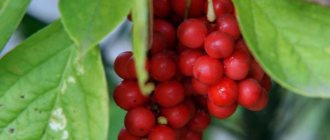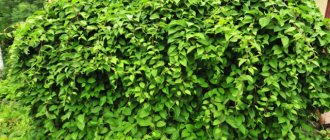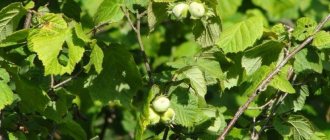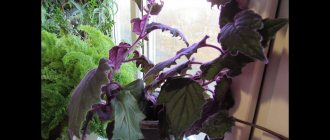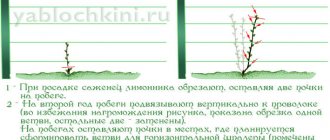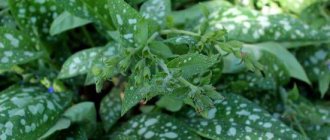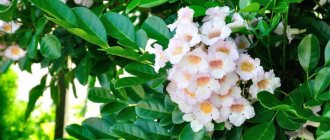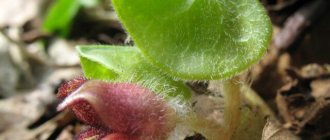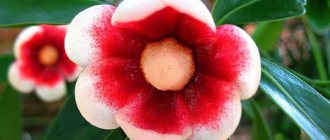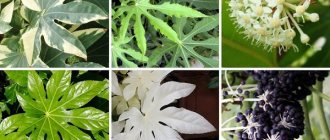Author: Natalya Category: Fruit and berry plants Published: August 17, 2017Republished: February 18, 2019Last edits: November 02, 2020
- Growing conditions
- Growing from seeds
- Medicinal properties
Chinese lemongrass (lat. Schisandra chinensis) is a species of the genus Schisandra chinensis of the Schisandra family, found in the wild on the edges and clearings of coniferous-deciduous and deciduous forests, in narrow valleys of streams and mountain rivers, in old burnt-out areas and clearings in Korea, Japan, China and Russia. territories of the Far East. It grows in groups, forming thickets and rising into the mountains to a height of up to 600 m above sea level. Schisandra chinensis has been cultivated for a very long time: it began to be cultivated for medicinal purposes at least 250 years BC.
Planting and caring for Schisandra chinensis
- Flowering: from the fifth to sixth year of life in late May or early July. Flowering lasts about two weeks.
- Planting: in October or late April-early May.
- Lighting: bright sunlight or partial shade.
- Soil: light, rich in humus, moderately moist and drained.
- Watering: frequent and abundant: 6-7 buckets of water are poured under each bush.
- Fertilizing: from the third season, once every 2-3 weeks, organic fertilizer is applied to the tree trunk circle - a solution of chicken manure or mullein. The tree trunk space is mulched with a layer of humus or leaf compost. In autumn, 20 g of superphosphate and 100 g of wood ash are embedded into the soil under each plant to a depth of 10 cm.
- Garter: the trellis on which this vine is grown is installed immediately after planting. When the vine is located near the wall of the building, it is let down a ladder installed obliquely to the wall.
- Pruning: from the third year after planting, formative pruning begins, which is carried out in the fall, after leaf fall. Unnecessary root shoots are also removed.
- Reproduction: seeds, root cuttings and shoots.
- Pests: not affected.
- Diseases: powdery mildew, ramularia, ascochyta and fusarium.
- Properties: is a valuable medicinal plant.
Read more about growing Schisandra chinensis below.
Common varieties
From 15 to 23 species of Schisandra chinensis grow in nature. The following species can most often be found in summer cottages:
- Garden One. This hybrid is self-fertile and does not require pollinators. It is characterized by good yield, resistance to cold and speed of shoot growth. Ripe fruits are juicy, the pulp tastes sour. The cluster has an average length of about 9-10 cm and consists of 22-25 berries. The yield per adult plant is on average 4-6 kg.
- Mountain. This variety was first bred in the Far East and has an average fruit ripening period. Ripe berries can be picked at the end of August. The variety has good immunity and tolerates winter well. The average length of the brush is 8-9 cm, and the weight is 12-13 grams. It consists of fruits of a dark scarlet color, with bitterish pulp and noticeable sourness. The dense flesh is quite juicy. The yield per plant is about 1.5-2 kg.
- Volgar. This variety is winter-hardy, tolerates drought well, and is resistant to diseases and pests. Most often, a plant produces both “male” and “female” flowers at the same time, but occasionally there are seasons when only “male” flowers are formed. It is recommended to collect ripe fruits in early September. The weight of the brush, which consists of 13-15 berries, is 6-7.5 grams. The berries have a pronounced resinous aroma, the pulp tastes sour.
- Firstborn. The variety is one of the latest achievements of Russian breeders, bred in Moscow. It is resistant to frost and diseases. The berries are purple-scarlet in color, have an elongated shape, and are small in size. The fruit pulp is bright red. The brush is about 12 cm long and weighs 10-12 grams. The plant is monoecious, the bush is medium-sized. A significant disadvantage of this type is low resistance to frost and weak immunity. The liana usually has a length of no more than 5 meters.
- Myth. The origin of this hybrid variety is not known for certain. The clusters with fruits are not too long - about 7 cm, while the berries are not very sour and are suitable for fresh consumption. There are about 15-18 pieces in each fruit.
- Oltis. The species was bred in the Far East, is distinguished by good yield - about 3-4 kg per bush, and resistance to diseases and viruses. The fruits are small in size, dark scarlet in color. The length of the brush is on average 9-11 cm, and the weight is 25-27 grams. Each fruit cluster contains 25-30 berries. The pulp of the fruit is bitterish-sour.
- Purple. This variety is one of the oldest; it was bred in 1985 in the Far East. Ripe fruits can be harvested in late summer. The first berries are harvested 3-4 years after planting on the site. An adult plant produces 3 to 4 kg of berries per season. The variety is winter-hardy and is often susceptible to diseases and viruses. The berries are small in size and the plant clusters are compact. The fruits taste sour and are covered with scarlet skin.
Watch the video! Schisandra chinensis planting cultivation care
Botanical description
The plant is a climbing deciduous vine up to 15 m long with a trunk up to 2.5 cm in diameter and shoots covered with brown-brown bark, flaky on old ones, and shiny and smooth on young ones. Both the shoots and leaves of lemongrass have a characteristic citrus aroma, from which the plant gets its name.
The leaves of Schisandra are dense, obovate or elliptical, with a wedge-shaped base and a few and indistinct teeth along the edges. The leaves are connected to the shoots by pink or red petioles up to 3 cm long. In spring and summer, the upper part of the leaf blade is light green, shiny, bare, and the lower part is bluish, with pubescence along the veins. In autumn, the leaves of Schisandra chinensis turn yellow-orange and ocher-yellow.
Growing lemongrass: planting and care in open ground
Fragrant, waxy white dioecious flowers up to 2 cm in diameter on drooping pedicels are located in groups of 3-5 in the leaf axils. The aggregate racemose fruit, up to 10 cm long, consists of edible spherical two-seeded berries of red color and sour taste. The berries of Chinese lemongrass also have a characteristic smell of the plant. The kidney-shaped seeds of Schisandra chinensis remain viable only until spring.
- Double pruning according to Sobolev
Description of the plant
Chinese lemongrass is a perennial climbing plant . Its spherical fruits have a characteristic lemon flavor. In nature, this plant can most often be found in the Amur Region, Khabarovsk and Primorsky Territories, which is why it is often called Far Eastern Schisandra. Growing and caring for vines today is available to gardeners in Russia, the Baltic states, Belarus, and Ukraine.
The liana belongs to the Schisandraceae family. In total, more than 20 species of this plant are known. Only one species grows in Russia - Chinese Schisandra. Its characteristics include the following parameters :
- The lemongrass trunk can grow up to 17 m in height, while being about 3 cm thick.
- As the vine grows, it wraps around shrubs and tree trunks growing in the neighborhood.
- Its inflorescences resemble magnolia in appearance.
- The young stem is yellowish in color; with age it changes to dark brown.
- The leaves are pointed, elliptical in shape, 5-10 cm long.
- On one branch there are simultaneously male and female flowers, growing on a long stalk and possessing a pleasant aroma.
- Flowering begins in late spring and does not last long.
- At the end of flowering, grape-like clusters of 20-25 berries form on the plant.
- Fruiting occurs in August-September. You can collect up to 3 kg of berries from one vine.
In addition to its decorative qualities, lemongrass is famous for its healing properties and is actively used in folk medicine. The Chinese call lemongrass “the berry of five tastes” due to the fact that the skin of the fruit is sweet, the pulp is sour, and the seeds are bitter and have a tart taste, and when stored for a long time, the taste of the seeds becomes salty or insipid.
In the East, this plant is compared in value to ginseng. Schisandra has strong stimulating properties and is used to treat many diseases.
Planting Schisandra chinensis
When to plant
Growing and caring for Schisandra chinensis is carried out not only for medicinal purposes, but also for decorating the site, since the plant has high decorative qualities. In areas with a warm, mild climate, lemongrass is planted in October, and in the middle zone, planting is carried out at the end of April or beginning of May. Professionals recommend planting at least three plants at a distance of 1 m from each other. If you want to grow a vine near the house, step back 1-1.5 m from the wall so that water from the roof does not drip onto the lemongrass.
How to plant
Schisandra prefers light, but humus-rich, moist and well-drained soil. The plant is shade-tolerant, but will develop better in a well-lit place.
Two- to three-year-old seedlings are used as planting material, which, with a shoot height of only 10-15 cm, have a well-developed root system. Before planting, taller shoots of the seedling are shortened to 3 buds, and the roots are trimmed to 20-25 cm.
A planting hole for Schisandra chinensis is dug with a diameter of 60-70 cm and a depth of at least 40 cm. A drainage layer of expanded clay, broken brick or crushed stone 10 cm thick is laid on the bottom, and to fill the hole a soil mixture is prepared from equal parts of humus, leaf compost and turf earth, adding 200 g of superphosphate, half a kilogram of wood ash and mixing thoroughly. Before planting, pour the soil mixture onto the drainage layer.
Dip the roots of the seedling into a clay mash, add 1 liter of mullein to a bucket, and place the plant on a mound so that its root collar is at surface level after planting. Spread the lemongrass roots and fill the hole with prepared fertile soil. Then compact the soil in the tree trunk circle and water it generously, and when the water is absorbed, fill the root hole with humus or peat. Chinese lemongrass seedlings take root very quickly, but it is advisable to initially protect them from bright sun, provide regular watering and evening spraying in dry weather.
Landing
Schisandra seedlings are purchased from a specialized nursery. It is best to take specimens that are 2 or 3 years old. They have a higher survival rate. When choosing planting material, special attention should be paid to inspecting the root system. It should be healthy, without signs of rot or mold, branched.
Important! Schisandra does not tolerate stagnant water, so it will not take root in swampy areas or will constantly get sick.
Preparing the site
Do not forget about high-quality preparation of the landing site. To begin with, you should choose an area with optimal lighting. A semi-shaded area next to trees, outbuildings, arches or gazebos for relaxation is best suited. This plant definitely needs support. If the area is open, then you will have to build it in the year of planting. It is worth paying special attention to soil moisture. The groundwater level should not be higher than 2 m.
Schisandra planting in Siberia is carried out only in the spring, because when manipulation is carried out in the fall, the plant will not have time to gain enough strength and take root, which will prevent it from surviving the frosts. Preparatory work on the site begins in the fall. To begin with, clear the area of plant debris and stones. Then the soil is cultivated to a depth of 30 cm. Immediately after this, the soil is disinfected using a solution of copper sulfate (3%) - 300 g of powder is added to 10 liters of water. This will be enough to process 10 m² of area.
A week after disinfection, the following is added to each square meter:
- 20 kg of humus;
- 10 kg of turf soil;
- 1 kg wood ash.
After adding nutrients, digging is carried out to a depth of 20 cm.
The holes are prepared immediately before planting. If several plants are planted, then a distance of at least 1 m is left between the holes. In rows, the step is similar. When planting next to outbuildings, at least 1.5 m are retreated from the wall.
Read the description of varieties of Schisandra chinensis.
The depth should be within 40 cm, width - 60 cm. The bottom of the hole must be covered with a layer of drainage (pebbles, expanded clay, etc.) 15 cm thick. The soil from the hole is mixed in equal proportions with leaf humus, compost, turf soil, and also added to this mixture is about 2 cups of wood ash.
Landing is carried out as standard:
- A seedling is placed in the hole.
- Fill the voids with a nutrient mixture.
- The trunk circle is compacted.
- Water with 10 liters of water.
- After absorbing moisture, mulch with a layer of compost mixed with peat (1:1).
- The shoots are tied to a support.
Seedling preparation
Preparatory work with a seedling is very easy to perform. The roots of the plant should first be immersed in a growth accelerator for 10 hours. “Epin” is suitable for this. Add 1 ampoule of the drug to 5 liters of water. In principle, this is the entire pre-planting treatment of the seedling. After this, they immediately proceed to planting the plant in open ground, in pre-prepared holes.
Caring for Schisandra chinensis
Growing conditions
Planting Schisandra chinensis and caring for it is not labor-intensive and will not take up much of your time. The main care measures are watering, loosening the soil, removing weeds, fertilizing, spraying in prolonged dry heat and pruning.
During the growing season, lemongrass is watered frequently and abundantly: 6-7 buckets of water are poured under the plant at a time. The next day after moisture or rain, you need to loosen the soil around the vine and remove weeds. Do not neglect evening spraying of Chinese lemongrass in the heat. Young vines especially need this procedure. To prevent the rapid evaporation of moisture from the soil, it is better to always keep the tree trunk under mulch made of organic material.
They begin to feed Chinese lemongrass from the third year of life: during spring and summer, a solution of organic fertilizers - cow (1:10) or chicken (1:20) manure - is added to the soil once every two to three weeks. A good result is obtained by mulching the trunk circle of Schisandra chinensis with humus or leaf compost. After leaf fall, 100 g of wood ash and 20 g of superphosphate are added under each bush, followed by embedding to a depth of about 10 cm with mandatory subsequent watering of the soil in the tree trunk circle.
During the flowering period, fruit-bearing vines are fed with Nitrophoska at the rate of 50 g per m², and after flowering, a bucket of a solution of fermented mullein or bird droppings is poured under the plant. In autumn, 60 g of superphosphate and 30-40 g of potassium sulfate are scattered under the bushes, and once every 2-3 years, compost is poured under each plant to a depth of 6-8 cm at the rate of 4-5 kg per m².
Schisandra chinensis, since it is a vine, is grown on a trellis, which is installed in the year the plant is planted. This arrangement of branches and shoots allows the sun's rays to better illuminate the plant, and this contributes to the formation of larger fruits and an increase in yield. If you grow lemongrass without support, it is unlikely to bear fruit. The trellis is made from pillars of such a height that after digging to a depth of 60 cm they rise above the ground by 2-2.5 m. The distance between the pillars is maintained at about 3 m, and they are connected to each other by three rows of horizontal wire guides, the lower of which is stretched by height of 50 cm from the ground, and the next ones every 70-100 cm. In the first year, the regrown shoots are tied to the lower guide, and in subsequent years - to those located above. The shoots are secured to the support with a fan. For the winter, Chinese lemongrass is not removed from the trellis.
If you plant a vine near the house, then you can use a ladder installed at an angle as a support.
They begin to prune lemongrass in the third year after planting, when the development of its root system gives way to increased shoot growth. Not only the decorative appearance of Schisandra chinensis, but also the quality of its fruiting depends on proper pruning. During the first formative pruning, 3 to 6 of the strongest and correctly positioned shoots are left on the bush - the future skeleton of the plant, and the remaining shoots are cut out at ground level. In the future, pruning of Schisandra chinensis is carried out twice a year: in autumn and summer. In the fall, after all the leaves have fallen from the plant, cut out weak, diseased, improperly growing and dried shoots that formed over the summer. The part of the vine that has been actively bearing fruit for the last three years should also be removed. This is done so that young shoots of the vine can develop and produce a harvest.
In summer, lemongrass is pruned only if the plant has formed too many young shoots. Professionals advise cutting branches 10-12 buds from the edge. In addition, it is necessary to combat root shoots annually, as well as regularly replace old skeletal branches with new strong shoots from the basal shoots.
- Autumn pruning of fruit trees
Pests and diseases
Schisandra has good immunity and, subject to agricultural practices and good care, is very rarely affected by diseases. It is also resistant to pests. However, if you receive infected planting material, you need to be prepared to deal with diseases. Most often, lemongrass is affected by spotting, powdery mildew and Fusarium wilt.
Among the spots, Schisandra chinensis is affected by ramularia and ascochyta blight. Brown blurry spots and edges on the leaves are the main signs of these diseases. Black dots called fungal pycnidia may appear on the underside of the leaf blade. Diseased leaves should be removed and burned, and the vine should be treated with one percent Bordeaux mixture or another copper-based fungicide.
Powdery mildew covers the leaves and stems of the plant with a sloppy whitish coating. As a result of the development of the disease, lemongrass leaves fall off prematurely. Powdery mildew also affects shoots, buds and roots of Schisandra chinensis. If its symptoms are detected, all affected leaves should be removed, and the plant should be treated with sulfur powder and soda ash solution until the vine recovers. Intervals between treatments are 7-10 days.
Fusarium can affect Schisandra at any age, but more often this problem happens to young plants. The cause of the disease is usually infection of planting material. Wilting is manifested by the formation of rotting areas on the root collar and roots of the plant. The stems of lemongrass darken, become thinner, the leaves turn yellow and fall off, and the vine dies from blockage of blood vessels. It is impossible to cure Chinese Schisandra from Fusarium, but it is quite possible to prevent the development of the disease if the seeds and seedlings are treated with a fungicide solution and the soil with Trichodermin before sowing and planting. If the plant does become sick, it will have to be removed and burned, and healthy bushes, before they become infected, should be treated with a solution of potassium permanganate.
Schisandra chinensis in the Moscow region
Schisandra chinensis has long been common in the Moscow region, as is Schisandra chinensis in the Urals, since the plant normally tolerates even harsh winters down to -35 ºC, and the decorative and medicinal qualities of this crop, as well as its ease of care, make the Far Eastern liana increasingly popular among gardeners. lovers. In the middle zone, Chinese lemongrass does not need to be laid on the ground or covered for the winter; only young plants need protection from the cold, and then only in the first winter. But in the conditions of Siberian frosts, the lashes are carefully removed from the trellis, placed on a bed of spruce branches or straw and generously sprinkled on top with leaves, straw or covered with spruce branches.
Schisandra in the Urals and Moscow region
For Chinese Schisandra, planting and care in the Urals has long become commonplace, since the plant easily tolerates frosty winters down to -35°C. But in the northern region there may be more severe frosts, so it is better to build a shelter for the vine for the winter. To do this, the lashes are removed from the support and carefully placed on a pillow of straw or spruce branches. The shoots are sprinkled with dry leaves on top and also covered with spruce branches.
In central Russia, lemongrass is not removed from its support for the winter, but is left in its usual position. Only young plants in their first year of life require shelter. In the Moscow region, lemongrass can be found quite often. The culture attracts gardeners with its high decorative qualities and medicinal properties. Another advantage of the woody vine is its unpretentiousness.
Propagation of Schisandra chinensis
Schisandra chinensis propagates by seeds, shoots and root cuttings, however, all the properties of the mother plant are preserved only during vegetative propagation.
Growing from seeds
The easiest way is to sow lemongrass seeds in prepared beds before winter, immediately after collecting them. You can sow in the spring, but in this case the seeds are stratified: they are kept in the bottom drawer of the refrigerator for two months. There is a very effective way to prepare seeds for sowing, developed by professionals: they are stored in fruits until January, then washed from the pulp, put in a nylon stocking and placed under constantly flowing water. At home, seeds in a stocking can be kept in the toilet flush tank so that they end up in fresh, clean water after each flush. After four days, the seeds are squeezed out, placed directly in a stocking in a container with wet calcined sand and kept for a month at a temperature of 18-20 ºC, after which the container with the seeds is buried in the snow for stratification. After a month, the seeds are brought into a room with a temperature of 10 ºC and observed: after a week or two they begin to crack, and then they can be sown to a depth of 5 mm in boxes with a mixture of sand and humus in equal parts. The crops are covered with paper and watered daily. Shoots with large cotyledons, similar to cucumber sprouts, will appear in 1-2 weeks. Caring for seedlings consists of protection from direct sunlight, watering and 1-2 treatments with a weak solution of potassium permanganate to prevent blackleg and other fungal diseases. At the stage of development of 3-4 true leaves, the seedlings are planted in larger boxes according to a 5x5 cm pattern, and in early June, after the warmth has finally set in, the hardened Schisandra chinensis seedlings can be planted in open ground in partial shade. The feeding area of one plant is 10x10 cm². Protect the seedlings from too much sun, and with the onset of autumn, cover them with spruce branches or a thick layer of foliage. Schisandra chinensis is planted in a permanent place from seeds at two to three years of age.
Reproduction by shoots
The most effective method of propagation is planting shoots. The liana is literally surrounded by many shoots on which dormant buds are located. The offspring are separated from the bush and immediately transplanted to a permanent place. In the southern regions, this can be done before the start of sap flow and after leaf fall, and in the northern regions - only in early spring.
Propagation of lemongrass by root cuttings
From the rhizome, cut pieces of roots from 5 to 10 cm long with several dormant buds and, to prevent the overgrown roots from drying out, immediately sprinkle the pieces with damp soil or cover them with a wet napkin. Then the root cuttings are planted in a garden bed or in a cold greenhouse according to a 10x10 pattern and covered with a layer of fertile soil 2-3 cm thick. Planting care involves regular watering. In the spring of next year, the cuttings that have sprouted are planted in a permanent place.
Pests and diseases of lemongrass
Not a single harmful insect settles on lemongrass, most likely this is due to the specific smell of this plant. It also has a fairly high resistance to diseases, but sometimes such a vine gets sick.
Leaf spot
Ascochyta
blight This crop can be affected by leaf spot. In infected specimens, blurry brown spots with black dots on the pycnidia appear on the lower surface of the leaf blades. This disease has one peculiarity: it can be bacterial or fungal in nature. To cure a vine, you need to spray it with a preparation containing copper.
Phyllosticosis
If large, almost black spots with a purple border appear on the leaf blades, this means that the plant is infected with leaf phyllosticosis. In some cases, the affected tissue located in the center of the spot becomes colored and falls out, and a hole appears in its place. As a rule, only old foliage is affected by this disease. An infected plant should be treated in the same way as in the case of spotting.
Ascochyta blight
If Schisandra is infected with ascochyta blight, then brown spots form on its surface, reaching 2 cm in size, and they have clearly defined zones. The diseased bush should be sprayed with a solution of Bordeaux mixture (1%).
Ramulariasis
Schisandra can also develop a fungal disease such as ramulariasis. On the affected specimen, brown single spots, angular or rounded, form, while their central part has a paler color and a pink coating appears on it. The diseased plant must be treated with a fungicide.
Powdery mildew
When affected by powdery mildew, a loose whitish coating appears on the surface of the shoots and leaf blades. Gradually the coating becomes dense and brown. If the disease is at an initial stage, then you can get rid of it by treating the bush with soda ash. If the disease is advanced, then for spraying it will be necessary to use a preparation containing copper.
Fusarium
The seedlings of this plant are susceptible to fusarium. Because of it, a constriction (dark ring) is formed in the lower part of the stem. After some time, the shoot in this place becomes soft, which leads to the death of the plant. Infected plants must be pulled out, and the substrate must be shed with a weak solution of potassium manganese.
Varieties of Schisandra chinensis
Unfortunately, there are not so many varieties of Chinese lemongrass. Currently, the most famous of them are:
- Garden-1 is a self-pollinating, highly productive winter-hardy variety, the branches of which reach a length of 10 m. The fruits of Schisandra chinensis of this variety consist of spherical juicy and sour red berries with the smell of lemon, collected in racemose fruits up to 10 cm long;
- Mountain -hardy and productive variety of medium ripening, relatively resistant to diseases and pests. The fruit up to 9 cm long and weighing up to 13 g consists of 15-17 dark red berries with a bitter-sour taste;
- Volgar is a winter-hardy, drought-resistant, late-ripening lemongrass that is practically not affected by diseases and pests and has a universal purpose. It is a monoecious liana with fruits weighing up to 7.3 g, consisting of 14-15 round red fruits of a sour taste with a resinous aroma;
- Pervonets is a frost-resistant, disease- and pest-resistant medium-ripening variety of Russian selection with carmine-red fruits with juicy bright red flesh, a specific sour taste and lemon aroma;
- Myth is a hybrid variety of unknown origin with medium-length fruits, consisting of 15 red fruits with a pleasant sour taste.
What does Chinese lemongrass look like?
Chinese lemongrass (Schisandra chinensis) is a representative of a small variety of the Schisandra family.
Interesting! The plant received its name because of the characteristic smell of lemon zest, which is inherent in the leaves and shoots. Apart from this feature, lemongrass has nothing to do with citrus fruits.
In nature, lemongrass has significant overall dimensions. A vine with a climbing stem has a length of about 12-15 m, without any restrictions. The diameter of the stem is small, 2.5-3 cm. The branches are covered with brown bark. The leaf blades have the shape of a wide oval or ovoid, are dense and leathery to the touch. There are almost invisible teeth on the edges of the leaves. The flowers that appear in the spring resemble magnolias made of wax.
Ripe lemongrass berries are bright scarlet in color and have a spherical shape. The fruits are collected in 15-25 pieces in clusters 8-12 cm long and resemble bunches of grapes or red currants. The berries have a pleasant citrus aroma. Each contains 1-2 large seeds. The taste of the fruit is extremely specific, since it contains:
- organic acids;
- resins and tannins;
- essential oils.
The skin of the berries has a sweetish-salty, tart taste. The seeds have a bitter taste, and the juice is sour and astringent.
The productivity of the plant is quite high; on average, about 3-5 kg of berries can be collected from one plant. During the “burst” period, which happens once every 3-7 years, the vine bears 1.5-2 times more fruit than usual. The mature harvest is harvested in late summer or early September.
Healthy! Schisandra chinensis is a dioecious plant, so pollination and subsequent fruiting is possible only if there are plants on the site with both “male” and “female” flowers.
Properties of Schisandra chinensis - harm and benefits
Medicinal properties
For medicinal purposes, the fruits and seeds of the plant are mostly used. The fruits of Schisandra chinensis contain resinous substances, schisandrin, potassium, organic acids (malic, citric and tartaric), vitamins, mineral salts, trace elements copper, iodine, selenium, manganese, iron, zinc, essential oil.
The beneficial properties of this species were known back in Ancient China and the plant was actively used in pharmacology. Today, Schisandra chinensis is grown on an industrial scale. The berries of the plant have the ability to tone and stimulate the nervous system, which is why Nanai hunters take a handful of dried fruits with them when setting off on their journey. And not so long ago, tests involving military personnel and athletes showed that Schisandra has the property of relieving fatigue during intense physical exertion: just 2-5 berries of Schisandra chinensis have a stronger effect than phenamine or cola, but, unlike these stimulants, they do not give negative side effects. Schisandra chinensis berries are also indicated for those who engage in intense mental work, and it is very important that their tonic effect does not deplete nerve cells.
Schisandra preparations increase the body's resistance to diseases and adverse environmental influences, stimulate the respiratory system and the functioning of the heart muscle. They are often prescribed for the complex treatment of diseases caused by asthenic and depressive states. It is indicative that as a result of taking Schisandra chinensis preparations there were never any signs of overexcitation.
Fresh lemongrass berry juice can inhibit the development of many pathogens. The high effectiveness of treating chronic gastritis with the seeds of the plant has been proven: even a single dose of powder from the seeds of Schisandra chinensis led to the normalization of gastric acidity in patients suffering from either too high or low levels.
- Lemon: growing from the seed
To summarize, we can say that Chinese lemongrass has a positive effect:
- with a general loss of strength;
- with high mental or physical stress;
- with low blood pressure;
- for bronchitis, asthma and tuberculosis;
- with anemia;
- with sexual weakness;
- for diseases of the stomach, kidneys and liver.
Contraindications
Schisandra chinensis, like other medicinal plants, has its own contraindications. You cannot eat its berries, drink its juice or take plant preparations for the following conditions and pathologies:
- vegetative-vascular dystonia;
- allergy;
- epilepsy;
- pregnancy;
- increased excitability;
- arterial hypertension;
- insomnia;
- arachnoiditis;
- increased intracranial pressure;
- acute infectious disease.
Chinese lemongrass, growing features and methods of propagation
Schisandra chinensis has been cultivated for more than 15 centuries.
It is used in folk and official medicine. Culture can save a person from diseases of the digestive, nervous and respiratory systems. Many gardeners are not averse to acquiring such a valuable plant. But not everyone knows how to care for it, and whether it will take root in the climatic conditions of the middle zone. Practice has shown that the Far Eastern shrub is successfully grown in Russia, as it can easily withstand severe frosts.
Care
Caring for lemongrass consists of following simple rules, and all the necessary procedures will not take much time from the gardener.
Watering
Schisandra chinensis is a moisture-loving plant. The norm for an adult vine is a volume of 60-70 liters of water, and it should be watered 2-3 times a week.
Top dressing
With proper preparation of the planting hole, the nutrients contained in the soil will be sufficient for the growth and development of the plant and will last for the next 2 years. It is recommended to fertilize lemongrass starting from the 3rd season of stay on the site.
It is best to use organic matter as fertilizer. Schisandra grows quite quickly, so it should be watered every 15-20 days with a solution consisting of:
- cow dung;
- bird droppings;
- nettle leaves;
- dandelion
This mixture should be infused for 3-4 days, having previously been diluted with water in a ratio of 1:10, and the litter - 1:15. Complex fertilizers are also used (40 g per 1 sq.m.), which contain potassium, phosphorus, and nitrogen:
- Nitrophoska;
- Azofoska;
- Diammophos.
Every 2-3 years during the growing season, 25-30 liters of humus or rotted compost are added to the tree trunk circle. After the ripe fruits are harvested, the plant needs to receive sufficient amounts of potassium and phosphorus. For this:
- 40-50 grams of superphosphate and potassium sulfate;
- must be diluted in 10 liters of water;
- or distribute dry over the tree trunk while loosening the soil.
You can also use natural fertilizer; wood ash taken in a volume of 0.5-0.7 liters is suitable for this.
Shelter for the winter
There is no need to cover lemongrass for the winter in regions with warm climates. In regions with severe and prolonged frosts, it is worth being safe.
First of all, the shoots are detached from the trellis and laid out on an area covered with a layer of mulch, 10 cm thick. The plant should be covered on top with straw, spruce or pine spruce branches, fallen leaves, burlap or covering material that allows air to pass through well. Before this, it is necessary to water, spending 80 liters of water on each plant.
Pruning lemongrass
Initially, pruning of the vine is carried out during planting, later - in the third season of growth in open ground. It is necessary to leave 5-7 of the strongest and healthiest stems on the vine, the rest must be removed to the point of growth. Pruning is then carried out regularly during the spring and autumn months.
Recommendation! All frozen, dried out and broken shoots should be removed in early March. Since carrying out such a procedure during the period of active growth of magnolia vine can lead to the death of the plant.
After the foliage has fallen, in the fall, it is necessary to carefully remove intertwined, weak, diseased and deformed branches. It is also necessary to remove that part of the vine that has not produced fruit over the past 3 years. Carrying out this procedure helps to rejuvenate the plant and allow new shoots to develop properly.
15-18 years after planting, the first radical pruning is carried out to rejuvenate the plant. Leave 4-5 healthy shoots that bear fruit this year, and remove the rest.
